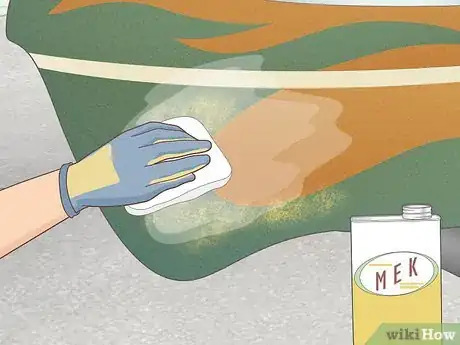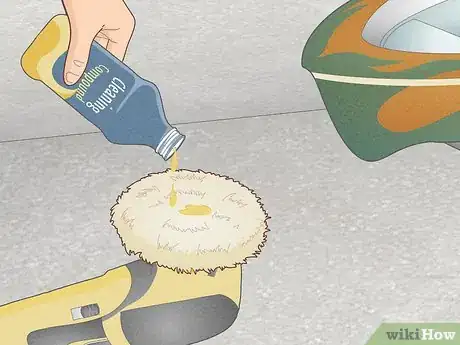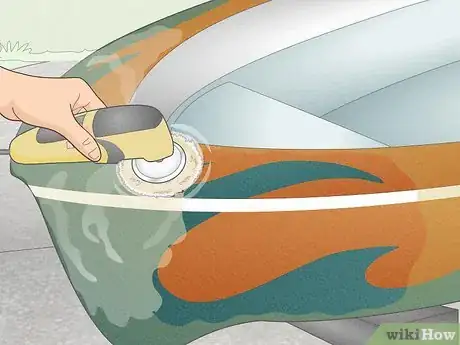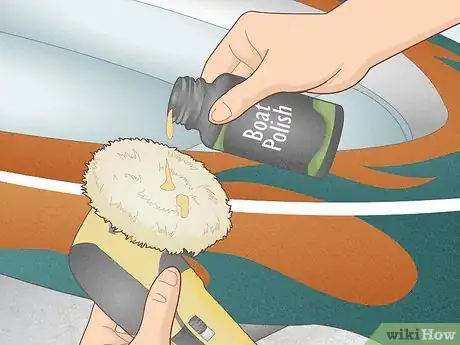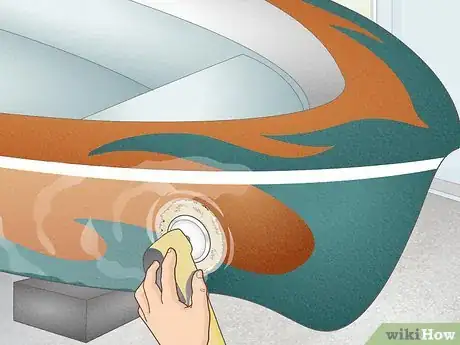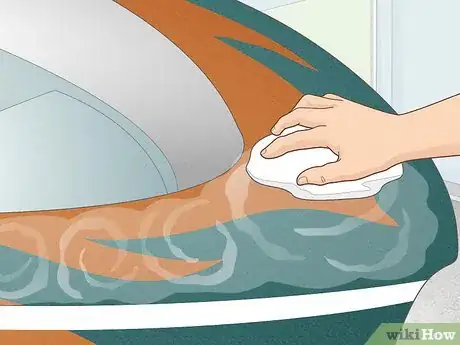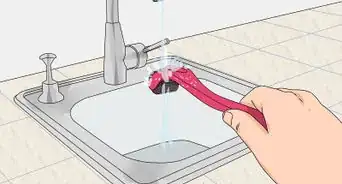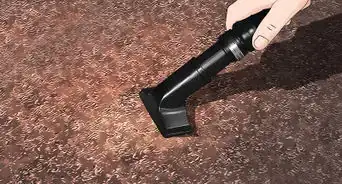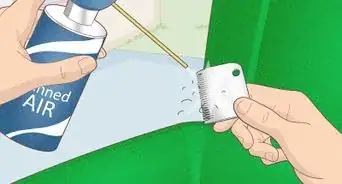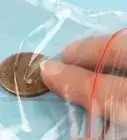This article was co-authored by Travis Lund. Travis Lund is the General Manager at the Vallejo Marina, a large marina located between the San Francisco Bay and the Delta in California. Sailing since he was six-years-old, Travis has over 15 years working in sailing operations and instruction and has pioneered a coaching platform that combined traditional coaching with multi-camera video support. He studied English at Michigan State University, where he was on the sailing team.
There are 10 references cited in this article, which can be found at the bottom of the page.
This article has been viewed 8,038 times.
Does the surface of your boat or RV have a yucky yellowish or grimy-looking appearance? It’s probably not dirt—it’s your gelcoat. Fiberglass often has an exterior coating, called gelcoat, that helps protect it and keep it nice and shiny. Over time, the gelcoat can oxidize and take on a dull, pale, or yellowish color. Fortunately, you can clean the gelcoat and restore it back to its original shine without too much trouble.
Steps
Buffing the Gelcoat
-
1Choose a fiberglass cleaner that’s safe for your gelcoat. The gelcoat surface of the fiberglass is actually a delicate surface, so you need to choose a cleaner that won’t damage it. Pick up a cleaner specially designed for fiberglass surfaces from your local boating supply store or hardware store.[1]
- You can also order fiberglass cleaners online.
- Many boat cleaners are designed to be used on gelcoat surfaces. A few examples include Star Brite Ultimate Fiberglas Stain Remover, Collinite Fiberglass Boat Cleaner, and TotalBoat White Knight Fiberglass Stain Remover.
-
2Clean the gelcoat surface with a cloth and fiberglass cleaner. Spray or apply the fiberglass cleaner onto the gelcoat surface. Use a clean cloth or towel to wipe the surface and remove dust, dirt, and grime.[2]
- Spend some time scrubbing off any stuck on dirt or stubborn grime from the gelcoat.
- The fiberglass cleaner won’t get rid of the oxidation, but it will lift dirt from the surface, which is super important before you buff and polish the surface.
Advertisement -
3Use MEK or acetone if you need to degrease the gelcoat. If the gelcoat on your boat or RV has oil and grease on it, put on a pair of thick rubber gloves and soak a rag in methyl ethyl ketone (MEK) or acetone. Wipe the surface of the gelcoat to remove the oily contaminants.[3]
- It’s really important that the gelcoat surface doesn’t have any oil and grease before you buff and polish it.
- MEK and acetone put off noxious fumes and can burn your skin so be sure to wear thick rubber gloves and work in a well-ventilated area.
-
4Apply compound to a wool buffer pad on an electric buffer. An electric buffer is a handheld tool that makes the job of buffing much easier. Attach a wool buffer pad to it, which is soft enough to prevent scratches or damage to the gel coat.[4] Apply a few drops of heavy-duty cleaning compound designed for boats and RVs.[5]
- Look for compound at your local boat supply store, RV supply store, or hardware store. Popular compounds include Meguiar’s One Step Compound, Presta Super Cut Compound, and 3M Perfect-It Gel Coat Medium Cutting Compound.
-
5Scrub the oxidation off of the gelcoat with your buffer. Turn on your electric buffer and gently press the wool pad to the gelcoat surface. Start at 1 end of the fiberglass and use circular motions to buff and lift stains from the gelcoat surface.[6]
- Continue buffing until the entire surface shines.
- Be sure to get the undersides and top of your boat or RV.
-
6Look for your reflection in the gelcoat to know you’ve buffed enough. Take a step back and check out the shiny gelcoat surface. Check for your reflection in the shiny surface. If you can’t, buff the area until you can.[7]
- Once you can see yourself in the gelcoat surface, you can stop buffing and move on.
Polishing and Waxing the Gelcoat
-
1Apply boat polish to a fresh wool pad on your buffer. Change out the wool pad you used to buff the gel coat for a fresh one. Use a polish designed for the gelcoat surfaces of boats and apply a few drops to the wool pad.[8] It might also be called a finishing compound.[9]
- Look for products like Presta Chroma 1500 polish, Meguiars M210 Ultra Pro Finishing Polish, or Star Brite Premium Marine Polish at your local boat supply or RV store. You can also order them online.
-
2Run the buffer over the gelcoat surface to gently polish it. Start the electric buffer so it’s rotating and gently press the wool pad against the gelcoat surface. Use circular motions with your buffer to polish the entire surface.[10]
- You may not notice a major difference after you polish the freshly buffed surface. But polishing helps to protect the gelcoat and keep it shiny.
-
3Add fiberglass wax to a cloth or foam pad. Choose a wax designed for gelcoat surfaces to help protect and prolong its life. Apply a few drops of the wax to a clean cloth or foam pad when you’re ready to wax the surface.[11]
- Think of wax as a final, finishing step to bring out your gelcoat’s polish and shine.[12]
- Choose an industrial fiberglass wax such as Farleca or Colonite Wax.
- Wax will help prevent the gel coat from drying out, and it will also help block some damage from the sun. In addition, if you don't use the wax, you may notice a powdery substance forming that could come off on your clothes and hands.[13]
-
4Use circular motions to apply the wax to the gelcoat. Hold the cloth or sponge against the gelcoat surface and start waxing using gentle, circular motions. Wax the entire surface of your boat, RV, or whatever gelcoat surface you’re cleaning.[14]
- You’ll notice a white residue that forms on the gelcoat surface. That’s totally normal.
-
5Allow the wax to dry then wipe away the excess with a cloth. Check the packaging of the wax to see how long it needs to dry. Wait for it to fully dry, take a fresh, clean cloth, and gently wipe away the hazy, waxy residue from the gelcoat to reveal the shiny surface beneath it.[15]
Expert Q&A
-
QuestionWhy is it important to polish a boat?
 Travis LundTravis Lund is the General Manager at the Vallejo Marina, a large marina located between the San Francisco Bay and the Delta in California. Sailing since he was six-years-old, Travis has over 15 years working in sailing operations and instruction and has pioneered a coaching platform that combined traditional coaching with multi-camera video support. He studied English at Michigan State University, where he was on the sailing team.
Travis LundTravis Lund is the General Manager at the Vallejo Marina, a large marina located between the San Francisco Bay and the Delta in California. Sailing since he was six-years-old, Travis has over 15 years working in sailing operations and instruction and has pioneered a coaching platform that combined traditional coaching with multi-camera video support. He studied English at Michigan State University, where he was on the sailing team.
Sailing Instructor & Executive Director, Treasure Island Sailing Center Gel coat oxidizes and it likes to have wax. It's rather porous, and it dries out. If that wax coating is not applied, there'll be a powdery substance that will come off on your clothes and your hands. The wax will also help reflect the light and prevent damage from the sun, which is its worst enemy.
Gel coat oxidizes and it likes to have wax. It's rather porous, and it dries out. If that wax coating is not applied, there'll be a powdery substance that will come off on your clothes and your hands. The wax will also help reflect the light and prevent damage from the sun, which is its worst enemy.
Warnings
- Wear thick rubber gloves and work in a well-ventilated area when you use MEK or acetone.⧼thumbs_response⧽
Things You’ll Need
- Fiberglass cleaner
- Cloths
- MEK or acetone (if you need to degrease)
- Compound
- Electric buffer
- 2 wool buffer pads
- Boat polish
- Fiberglass wax
References
- ↑ https://www.marinetalk.com/best-cleaners-for-fiberglass-boat/
- ↑ https://youtu.be/Ba9Gyr6qK6M?t=72
- ↑ https://www.boatus.com/expert-advice/expert-advice-archive/2012/july/how-to-restore-gelcoat-on-a-boat
- ↑ https://youtu.be/uiH7F6z02t4?t=66
- ↑ Travis Lund. Sailing Instructor & Executive Director, Treasure Island Sailing Center. Expert Interview. 24 April 2020.
- ↑ https://youtu.be/uiH7F6z02t4?t=109
- ↑ https://youtu.be/uiH7F6z02t4?t=147
- ↑ https://youtu.be/uiH7F6z02t4?t=189
- ↑ Travis Lund. Sailing Instructor & Executive Director, Treasure Island Sailing Center. Expert Interview. 24 April 2020.
- ↑ https://youtu.be/uiH7F6z02t4?t=205
- ↑ https://www.boatus.com/expert-advice/expert-advice-archive/2012/july/how-to-restore-gelcoat-on-a-boat
- ↑ https://youtu.be/uiH7F6z02t4?t=273
- ↑ Travis Lund. Sailing Instructor & Executive Director, Treasure Island Sailing Center. Expert Interview. 24 April 2020.
- ↑ https://www.boatus.com/expert-advice/expert-advice-archive/2012/july/how-to-restore-gelcoat-on-a-boat
- ↑ https://www.boatus.com/expert-advice/expert-advice-archive/2012/july/how-to-restore-gelcoat-on-a-boat
- ↑ https://www.boatus.com/expert-advice/expert-advice-archive/2012/july/how-to-restore-gelcoat-on-a-boat


